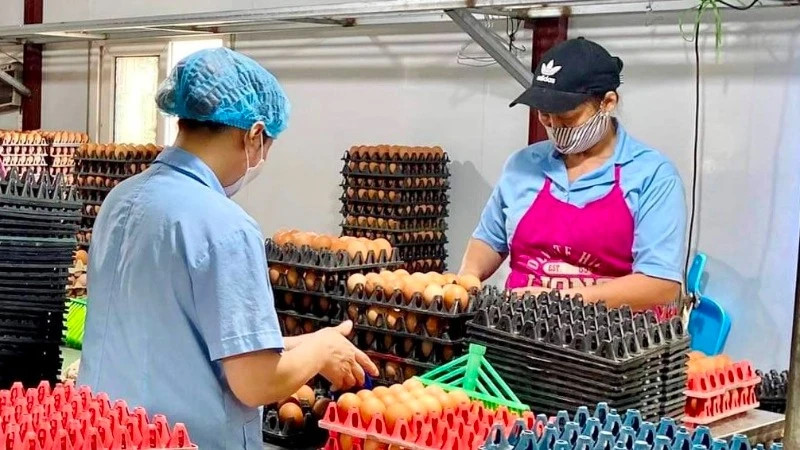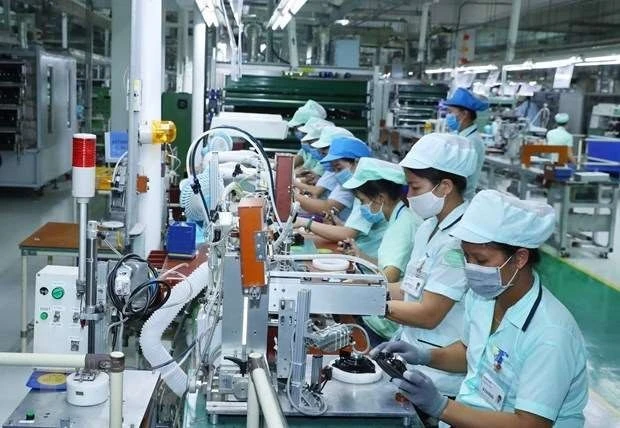The reality is that while the banking system is ready with credit resources, many businesses, especially small and medium-sized enterprises (SMEs), still face difficulties in accessing this capital source.
Creating financial leverage
In the current financial structure of Vietnamese enterprises, bank credit still accounts for the majority of businesses, especially the manufacturing sector. This credit flow is not only a means of operating production but also a vital factor in the strategy of expanding investment, accessing new markets, and improving the competitiveness of enterprises.
Miza Nghi Son Company Limited is an enterprise operating in paper recycling to produce high-quality packaging for domestic and foreign factories. The company started production in August 2021, and by 2024, its revenue reached 2.23 trillion VND, creating jobs for nearly 200 workers in the area and a source of input materials in districts in Thanh Hoa Province with an average monthly salary of more than 10 million VND/person.
According to Le Van Hiep - General Director of the Company, during the investment and implementation of projects in Thanh Hoa Province, the enterprise has always received support from credit institutions to provide capital for factory construction, purchase equipment and input materials. Currently, Miza Nghi Son’s total outstanding debt at credit institutions is approximately 1.5 trillion VND.
“In particular, during the difficult period after the COVID-19 pandemic, when the economy had not yet recovered and manufacturing enterprises like ours faced great pressure on raw material costs as well as the consumption market, Agribank Nam Thanh Hoa promptly implemented effective support solutions. Preferential credit programmes were flexibly applied, including waiving and reducing money transfer fees, providing loans with low interest rates, and many other practical policies that helped the company maintain production activities, especially in investment and business cooperation with suppliers of recycled paper materials in the province,” said Hiep.
Similarly, Le Van Phuong, General Director of Lam Son Sugar Company, shared that bank credit is not only a financial lever to help businesses maintain operations, but also a key factor to expand scale, invest in technology, and improve competitiveness. “In the current context, the sugar industry is facing many challenges, from price fluctuations, climate change, to increasing production costs, so the role of the banking system in providing financial support for businesses and farmers is very important,” Phuong affirmed.
By the end of March, the outstanding credit balance of the economy reached 16 quadrillion VND, up 2.5% compared to the end of 2024, up 17.65% compared to the same period in 2024 (while in the same period in 2024 it only grew by about 0.26%).
Deputy Governor of the State Bank of Vietnam (SBV) Pham Quang Dung.
According to Deputy Governor of the State Bank of Vietnam (SBV) Pham Quang Dung, although according to the rules of previous years, credit often decreased in the first months of the year due to the impact of the Lunar New Year, growth in early 2025 has shown signs of improvement compared to the same period in 2024. Specifically, by the end of March, the outstanding credit balance of the economy reached 16 quadrillion VND, up 2.5% compared to the end of 2024, up 17.65% compared to the same period in 2024 (while in the same period in 2024 it only grew by about 0.26%).
According to Deputy Governor of the State Bank of Vietnam (SBV) Pham Quang Dung, although according to the rules of previous years, credit often decreased in the first months of the year due to the impact of the Lunar New Year, growth in early 2025 has shown signs of improvement compared to the same period in 2024. Specifically, by the end of March, the outstanding credit balance of the economy reached 16 quadrillion VND, up 2.5% compared to the end of 2024, up 17.65% compared to the same period in 2024 (while in the same period in 2024 it only grew by about 0.26%).
But despite such positive signs, in the context of many challenges, to achieve the national credit growth target of 16% in 2025 (outstanding loans increased by 2.5 quadrillion VND compared to 2024) contributing to achieving the national economic growth target of at least 8% requires the entire banking sector to resolutely implement many solutions, along with cooperation from customers, businesses and support from the entire political system.
A policy push is needed
According to statistics, of the more than 900,000 enterprises operating in the economy, nearly 98% of them are small and medium-sized. Despite accounting for such a high proportion, the SME sector only has a total capital of 16.6 quadrillion VND, accounting for less than 30% of the total capital for production and business activities of the entire enterprise sector.
According to data from the State Bank of Vietnam, outstanding credit for SMEs by the end of 2024 reached about VND 2.74 quadrillion, an increase of 10.7% compared to the end of 2023, accounting for 17.6% of the total outstanding debt of the economy, with 208,992 enterprises with outstanding loans.
Despite the growth, this figure is still not enough to meet the capital needs of SMEs. And even though the interest rate level has decreased and the liquidity of the system is abundant, many businesses have not yet been able to access capital for production. This reality shows that the market requires a more substantial, synchronous and drastic policy "push" from the operator to effectively activate the credit flow.
Chairwoman of Ha Nam Food Joint Stock Company, Tran Thi Lan, acknowledged that to provide maximum support for businesses to develop, banks always create favourable conditions, from lowering interest rates during difficult times to quick loan procedures. But in the current context, banks need to continue to maintain preferential credit packages with interest rates and loan terms.
Sharing the same view, Phuong also recommended that the State Bank and commercial banks support preferential loans for farmers and businesses in the supply chain, through implementing more preferential credit packages and simplifying loan procedures. In particular, Phuong emphasised that collateral is still a big problem for businesses, so banks need to expand the form of mortgage by product consumption contracts between businesses and farmers to partly remove this bottleneck.
In reality, the bottleneck of capital flow lies in the credit approach that is still heavily dependent on collateral, lacking a credit valuation model based on cash flow and digital records of businesses. Businesses with development potential, export contracts, stable production chains, etc., but without large assets, are still eliminated from the “capital game”.
In addition to the resolution from banks, many opinions say that if enterprises build a transparent accounting, management and financial reporting system, it will help banks correctly assess the capacity of the enterprise, thereby creating favourable conditions for the loan approval process.
As an enterprise with typical projects with a total investment of nearly 1.8 trillion VND, of which loan capital is 1 trillion VND, accounting for 55% and all of these projects have been implemented, put into operation with high efficiency, bringing good revenue and cash flow, but General Director of CNC Technology Solutions Joint Stock Company (under CNCTECH Group) Dinh Thi Thu Ha said that enterprises still face several problems related to accessing capital, including difficulties due to lack of collateral.
Therefore, Ha recommended that the State Bank consider implementing more flexible credit guarantee mechanisms, including guarantees for businesses with potential production and business models but not enough collateral.
In addition to the solutions from banks, many opinions said that businesses building transparent accounting, management, and financial reporting systems will help banks correctly assess the capacity of businesses, thereby creating favourable conditions for the loan approval process.
According to ASCO Auditing Company Chairman Nguyen Thanh Khiet, businesses need to improve their management capacity, financial capacity and information transparency, apply technology and AI in accounting and financial management, etc.
For businesses to develop, not only credit capital but also long-term investment capital is needed, Dr Nguyen Dinh Cung - former Director of the Central Institute for Economic Management (CIEM) believes that the Government needs to open up a more diverse investment capital market, develop a capital market with various types of funds, and strongly develop a credit guarantee fund system to reduce risks for banks and support businesses without collateral. At the same time, it is necessary to improve the guarantee process to ensure transparency and efficiency, helping businesses save time and costs when accessing capital.
Although it is difficult to access credit capital, with the efforts of businesses, the timely support and companionship from banks, along with the right support policies of the State, it is hoped that these obstacles will gradually be resolved.
In the immediate future, to create a favourable environment for business development, each relevant party needs to make adjustments, improvements and continuous innovations. Close cooperation to jointly resolve difficulties between parties will be the “key” to opening the door to abundant credit capital, helping businesses break through in the new era.
















